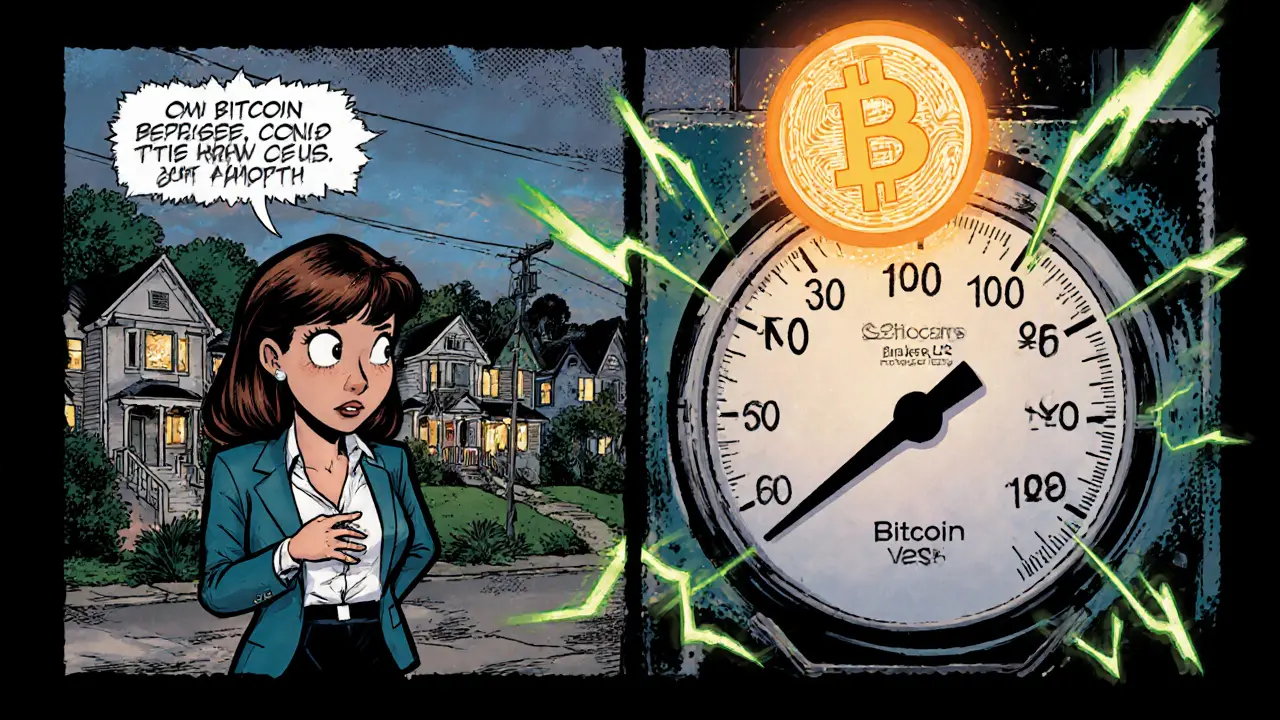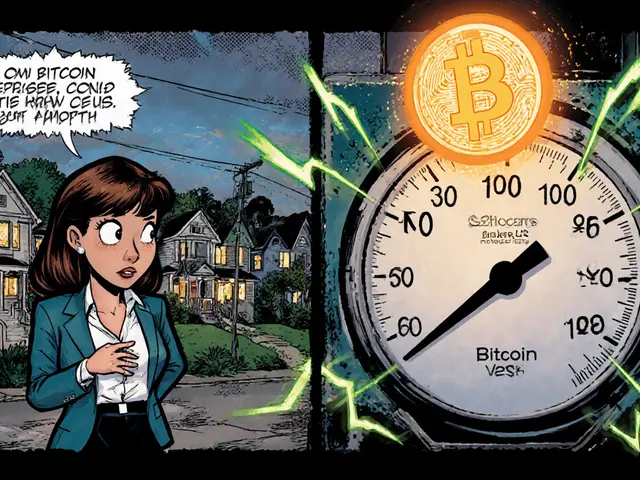- Home
- Cryptocurrency
- Proof of Work Blockchains: Environmental Impact and Sustainable Alternatives

Proof of Work Blockchains: Environmental Impact and Sustainable Alternatives
Proof of Work vs. Proof of Stake Energy Comparison
Proof of Work (Bitcoin)
112 TWh annually
62.5 Mt CO₂ emissions
707 kWh per transaction
Proof of Stake (Ethereum)
0.085 TWh annually
0.01 Mt CO₂ emissions
0.01 kWh per transaction
Energy Savings Calculator
Estimate the energy saved by switching from PoW to PoS:
Estimated Monthly Savings:
Note: This calculation assumes a PoW blockchain consuming 707 kWh per transaction and a PoS blockchain consuming 0.01 kWh per transaction.
Did you know that the energy used by a single Bitcoin transaction can power a typical U.S. household for a whole month? That shock‑value number illustrates why the environmental impact of proof of work is front‑page news in climate circles, finance desks, and policy rooms alike.
Proof of Work blockchains are decentralized networks that secure transactions by requiring miners to solve computational puzzles using high‑powered hardware. The process sounds elegant, but it forces computers to consume massive amounts of electricity 24/7. Below we unpack how that consumption translates into real‑world carbon, compare it with newer consensus models, and explore what governments, investors, and developers are doing to curb the damage.
Why PoW burns so much power
At its core, PoW asks miners to find a hash value lower than a target set by the network. The difficulty adjusts so that the entire network finds a new block roughly every ten minutes (Bitcoin) or two seconds (some newer chains). Because the puzzle is deliberately hard, miners must run GPUs, ASICs, or specialized rigs nonstop, feeding them electricity that often comes from fossil‑fuel plants.
Key numbers from the Cambridge Centre for Alternative Finance (CCAF) show Bitcoin’s annual electricity draw sits between 100 and 125 terawatt‑hours (TWh). That range is on par with the power consumption of whole nations like the Netherlands. One study by Bitwave estimates Bitcoin emits about 62million metric tons of CO₂ each year - roughly 0.5% of global electricity‑related emissions.
Measuring the footprint: electricity vs. carbon
Energy use alone doesn’t tell the whole story; the carbon intensity of the local grid matters. In regions where mining farms tap into coal‑heavy grids, the CO₂ per kilowatt‑hour can exceed 0.9kg, whereas a solar‑rich zone might emit less than 0.1kg per kWh. The aggregate impact is therefore a blend of location, hardware efficiency, and energy source.
For concrete perspective, a single Bitcoin transaction consumes around 707kWh - enough to power an average U.S. home for 23 days. By comparison, a typical Ethereum transaction under Proof of Stake (PoS) needs less than 0.01kWh, a difference of more than 70,000‑fold.
Enter Proof of Stake: the energy‑saving alternative
Proof of Stake replaces computational puzzles with a system where validators lock up cryptocurrency as collateral to propose and attest to blocks. Validators are chosen proportionally to their stake, removing the need for brute‑force mining.
The Ethereum "Merge" in September 2022 provides the most visible case study. The Ethereum Foundation reported a drop from about 8.5GW of power use to under 85MW - a 99.95% reduction. Carbon emissions fell from roughly 50MtCO₂ per year to an estimated 0.01MtCO₂, according to Carbon Copy Research Institute (CCRI). In other words, PoS networks collectively consume less than 0.001% of the electricity that powers Bitcoin.
Side‑by‑side comparison
| Metric | Proof of Work (Bitcoin) | Proof of Stake (Ethereum) |
|---|---|---|
| Annual electricity consumption | 112TWh | 0.085TWh |
| CO₂ emissions (Mt) | 62.5Mt | 0.01Mt |
| Energy per transaction (kWh) | 707kWh | 0.01kWh |
| Share of global electricity use | 0.5% | 0.00004% |
| Typical hardware | ASIC miners, GPUs | Standard servers/PCs |

Regulatory reactions around the world
Governments are moving from curiosity to concrete policy. The United States Treasury’s recent proposal would require large mining operations to report electricity consumption and pay a carbon‑based tax. The European Union, via its Sustainable Finance Disclosure Regulation (SFDR), now forces funds to disclose exposure to high‑carbon crypto assets.
In Asia, China’s 2021 crackdown on PoW mining forced many miners to relocate to regions with abundant renewable power, such as Inner Mongolia’s wind farms. Meanwhile, Kazakhstan introduced a licensing regime that includes a renewable‑energy quota for mining farms.
Across the board, the Organisation for Economic Co‑operation and Development (OECD) recommends mandatory environmental impact assessments for any new crypto‑asset project, effectively nudging developers toward PoS or hybrid models.
Industry initiatives and green offsets
Some miners argue that the solution isn’t to abandon PoW but to power it responsibly. Projects like Renewable‑energy‑backed mining farms locate mining rigs next to wind or solar farms to capture otherwise wasted electricity claim up to 80% renewable usage.
Platforms such as the Giving Block’s TGB Green and Gemini’s carbon‑offset program purchase verified credits to neutralize transaction‑related emissions. Yet experts note that offsets treat the symptom, not the cause, and that the opportunity cost of renewable energy diverted to mining could otherwise serve households, industry, or grid stabilization.
Investor pressure and ESG trends
Environmental, Social, and Governance (ESG) criteria are reshaping capital allocation. Funds like the Green Crypto Fund focuses on PoS and layer‑2 solutions that meet strict carbon‑intensity thresholds have attracted billions in assets. Tesla’s 2021 decision to suspend Bitcoin payments after a sustainability review sent a clear market signal that high‑carbon cryptocurrencies may be a liability for brand‑image‑sensitive firms.
Conversely, some institutional investors still hold Bitcoin for its “store‑of‑value” narrative, arguing that its scarcity outweighs the environmental cost. The debate highlights a split between traditional ESG purists and crypto‑optimists who view the network’s resilience as a non‑negotiable feature.
Future outlook: can PoW survive?
Technically, PoW offers unrivaled security: the sheer amount of computational work makes a 51% attack economically infeasible. However, the growing regulatory burden, corporate backlash, and shift in user sentiment suggest a narrowing niche.
Several emerging chains adopt hybrid models - for example, Proof of Authority uses a limited set of trusted validators to cut energy use while retaining fast finality - attempting to keep security without the power bill.
In the next five years, expect three trends:
- Policy tightening: More jurisdictions will impose carbon‑pricing or outright bans on PoW mining in regions with constrained grids.
- Capital migration: ESG‑focused investors will pour funds into PoS and layer‑2 protocols, raising their market caps and utility.
- Technical innovation: Research into low‑energy consensus (e.g., Proof of History, DAG‑based systems) will produce viable alternatives for use‑cases where PoW’s security is still valued.
Key takeaways
- The energy demand of PoW blockchains equals that of entire mid‑size nations, translating into tens of millions of tons of CO₂ annually.
- Proof of Stake reduces energy use by >99.9% and is rapidly becoming the default for new projects.
- Regulators worldwide are crafting carbon‑taxes, reporting mandates, and in some cases bans, to curb PoW’s environmental toll.
- Investors increasingly apply ESG screens, favoring PoS and green‑layer solutions over high‑carbon assets.
- While PoW may persist in Bitcoin and a few legacy networks, its growth potential is hampered by sustainability pressures.

Frequently Asked Questions
How much electricity does Bitcoin really use?
Current estimates place Bitcoin’s annual electricity consumption between 100TWh and 125TWh, comparable to the whole power demand of countries like the Netherlands. The figure fluctuates with miner profitability, hardware efficiency, and the geographic mix of mining operations.
Why is Proof of Stake considered greener?
PoS eliminates the need for energy‑intensive hashing. Validators simply hold and lock up tokens, which requires only modest server hardware. After Ethereum’s 2022 Merge, the network’s power draw dropped to under 85MW-a reduction of more than 99% compared to its former PoW state.
Can renewable energy completely offset Bitcoin mining?
Renewables can power some mining farms, especially in regions with excess wind or solar generation. However, mining runs 24/7, while solar and wind are intermittent. The real challenge is matching continuous demand with renewable output without diverting clean power from other critical uses.
What regulatory steps are being taken against PoW?
Several governments are drafting carbon‑tax regimes for mining, requiring energy‑use reporting, or outright banning PoW in regions with strained grids. The U.S. Treasury’s proposed “Crypto Mining Disclosure” rule and the EU’s SFDR inclusion of crypto assets are prominent examples.
Will Bitcoin’s carbon footprint improve without changing consensus?
Improvements are possible through more efficient ASICs and a shift toward greener grids, but the core energy demand remains high. Without a fundamental consensus change, Bitcoin’s footprint will likely stay in the multi‑tens‑of‑millions‑of‑tons range.
Cormac Riverton
I'm a blockchain analyst and private investor specializing in cryptocurrencies and equity markets. I research tokenomics, on-chain data, and market microstructure, and advise startups on exchange listings. I also write practical explainers and strategy notes for retail traders and fund teams. My work blends quantitative analysis with clear storytelling to make complex systems understandable.
20 Comments
Write a comment Cancel reply
About
DEX Maniac is your hub for blockchain knowledge, cryptocurrencies, and global markets. Explore guides on crypto coins, DeFi, and decentralized exchanges with clear, actionable insights. Compare crypto exchanges, track airdrop opportunities, and follow timely market analysis across crypto and stocks. Stay informed with curated news, tools, and insights for smarter decisions.





Looks like Bitcoin's energy bill could fund a small country, while Ethereum barely needs a nightlight.
It's encouraging to see the industry moving toward greener solutions; the PoS shift could really cut down the carbon footprint if more projects follow suit.
From a systems‑engineering perspective, the hash‑rate escalation manifests as a classic case of diminishing returns on energy investment, yet the market incentives remain misaligned.
Another day, another meme about Bitcoin burning electricity-yeah, yeah, we've heard it before.
For anyone looking to understand the numbers: PoW chains typically consume over 100 TWh per year, translating to roughly 70 Mt of CO₂, while PoS designs operate at a fraction of a percent of that energy usage. The key levers are consensus algorithm efficiency and validator participation rates.
What most people don’t realize is that the “green” narrative is often a front for hidden mining cartels that manipulate energy markets behind the scenes.
Sure, the climate crisis is real, but blaming Bitcoin alone is a convenient distraction from the real culprits-big tech data centers and fossil‑fuel subsidies.
Nice graphics, but the real issue is that people keep mining as if it’s free pizza.
Honestly, if you’re not questioning who funds the mining rigs, you’re just another pawn in the energy monopoly game.
It is heartening to observe that the sector is beginning to acknowledge its environmental responsibilities, and I remain hopeful that regulatory frameworks will further incentivise sustainable practices.
Ah, the drama of sustainability! One must ask: does the shift to PoS merely replace one form of digital tyranny with another, or does it herald a genuine renaissance of decentralized harmony? The answer, dear reader, lies not in the kilowatt‑hours but in the philosophical commitment to stewardship of our shared ether.
Let’s keep the conversation constructive-if you’re building a PoS network, consider sourcing validators from regions with abundant renewable energy; the collective impact can be huge.
When you look at the throughput metrics, you’ll notice that the bottleneck isn’t the consensus per se but the latency introduced by over‑engineered cryptographic primitives.
There are several layers to this discussion that merit a deeper dive. First, the raw electricity consumption numbers for PoW chains are staggering, and they translate directly into greenhouse‑gas emissions when the grid is powered by fossil fuels. Second, the move to PoS reduces the need for massive mining farms, but it also introduces new centralization pressures because staking power can accumulate in the hands of large holders. Third, beyond PoS, there are hybrid consensus models-such as proof‑of‑authority or proof‑of‑space‑time-that aim to strike a balance between security and energy efficiency. Fourth, the geographic distribution of validators matters; encouraging nodes in regions with abundant hydro or solar capacity can further cut the carbon footprint. Fifth, developers can design smart contracts that are mindful of computational complexity, since even on PoS platforms, excessive on‑chain computation translates to higher energy usage across the network. Sixth, layer‑2 solutions like rollups offload transaction processing from the base chain, thereby reducing overall energy per transaction. Seventh, policy incentives, such as tax breaks for renewable‑powered data centers, can accelerate the transition. Eighth, community governance can prioritize sustainability metrics alongside traditional performance metrics. Ninth, the public perception of blockchain’s environmental impact can influence investor behavior, pushing projects toward greener designs. Tenth, education is key: users need clear dashboards that show the energy impact of their transactions. Eleventh, the industry should adopt standardized reporting frameworks for energy consumption, akin to the carbon accounting standards used in other sectors. Twelfth, collaborative research between academia and industry can uncover novel consensus algorithms that are both secure and near‑zero‑energy. Thirteenth, transparent disclosure of the energy mix used by staking operators would allow users to make informed choices. Fourteenth, the integration of renewable energy certificates into staking rewards could align financial incentives with ecological goals. Finally, while technology can provide tools, the ultimate driver will be the collective will of the community to prioritize a sustainable future over short‑term profit.
It is abundantly clear that the discourse surrounding environmental stewardship in blockchain circles has been reduced to a series of platitudes, yet the underlying structural deficiencies persist unabated; one must interrogate the very epistemology of the so‑called "green" solutions while simultaneously acknowledging the sociotechnical entanglements that render simplistic remedies impotent.
Let me break it down for you: the PoW model is essentially a glorified electricity binge, where miners are incentivized to burn through power at any cost. When you compare that to PoS, the differences are stark-validator nodes don’t need massive rigs, they just lock up capital. That said, PoS isn’t a silver bullet; it can lead to wealth concentration, which is another form of systemic risk. Moreover, the environmental impact isn’t just about kWh; it’s also about the supply chain for hardware, the e‑waste, and the indirect emissions from cooling systems. If we want true sustainability, we must address the whole lifecycle-from mining equipment manufacture to eventual disposal. On top of that, the community should push for more transparent carbon accounting, so projects can be held accountable. In short, there’s no one‑size‑fits‑all answer, but moving away from energy‑intensive consensus is a solid first step.
Enough of the wishful thinking! If you don’t see PoW as a massive environmental nightmare, you’re either clueless or complicit. Switch to PoS now, or keep digging your own ecological grave.
Given the concerted efforts by shadowy cabals to mask the true energy consumption of blockchain networks, it is imperative that we approach these figures with a healthy dose of skepticism and demand rigorous, independently‑verified audits.
Appreciate the data, but remember that energy impact also depends on the local grid mix. Opting for validators in renewable‑rich regions can make a real difference.
While the infographics are visually appealing, the underlying premise that PoS automatically solves all environmental concerns is, frankly, an oversimplification that neglects potential centralization risks.